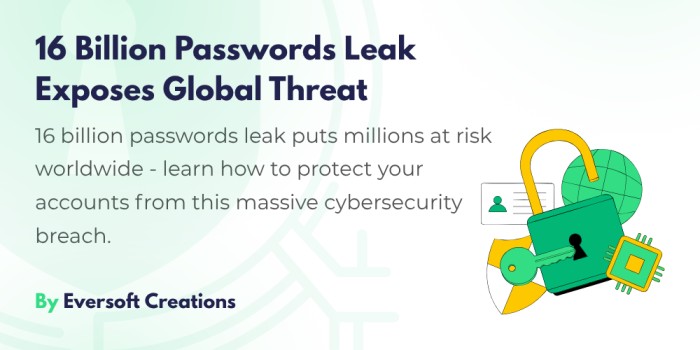This is alarming news, as in the largest known leak of stolen logins and passwords in internet history, cybersecurity experts have found out about a 16 billion passwords leak. The leak described by Cybernews and subsequently written about by a variety of media sources underlines the danger of infostealer malware and the black market marketplace on the stolen information. The 16 billion passwords leak targets not only popular websites and state databases but also encrypted databases, demonstrating the weakness of both the individual and institution in the modern digital environment.
This article sheds light on what happened during the leak, how the information was gathered, the possible dangers to them and above all, what you can offer to defend yourself.
Understanding the Scale of the 16 Billion Passwords Leak
When security experts discuss billions of records that are compromised, it is difficult to envision the true implication of the story. This 16 billion credentials leak is a collection of findings of more than 30 individual breaches, some having a non-billion number of entries. The irony in such leakage is not only the size in the volume, but it is also concerning because of the young age of the stolen credentials.
But in contrast to past breaches often reused, a large part of these 16 billion passwords was stolen with infostealer malware; it infects the devices in silence and collects log of passwords, cookies, browser autofills, and even two-factor authentication prompts.
That implies that most of the stolen login details are not yet useless and inactive; they can even be used at the moment which can become a direct threat to the people who have not bothered to reset their passwords or to protect their accounts.
How Was the Data Collected?
Most of the 16 billion passwords leak was collected by using the infostealers, which are sort of malware that obtains passwords and other confidential information by the user. After infecting a system of a victim, the malware transmits his/her login credentials and personal details to a command-and-control server that is controlled by hackers.
Such infostealers are usually distributed using:
- Evil email attachments
- Installation of cracked software downloads
- Fake browsers extensions
- Social engineering in form of phishing websites that pretend to be genuine platforms
After they have been harvested, they are bundled down to form huge lists and posted or raffled at the dark web forums and hacking groups. The peculiarity of this leak is the organization and volume of data- the database is organized and it can be easily attacked by multiple users.
Who’s Affected by the 16 Billion Passwords Leak?
This information leak does not concern a particular service or location. The leak is said to incorporate:
- Google and Gmail accounts
- Facebook and Instagram logins
- Apple ID credentials
- Microsoft accounts
- GitHub and developer portals
- VPN and cybersecurity tools
- Banking and financial institutions
- Government databases
- Email and messaging platforms (Telegram, Outlook, ProtonMail)
Such a large magnitude means that the leak of 16 billion passwords could reach billions of users worldwide, and some of them might not realize their data has been breached.
Why This Password Leak Is Different
Yahoo, LinkedIn, Adobe and other data breaches throughout the years are dangerous but this one is especially risky because of a few reasons:
- Recent Data: The biggest part of the leak is credentials that were stolen within the last 18 months and that are likely to remain active.
- Infostealer Harvesting: In contrast to usual hacks that were made by incompetent security of servers, these credentials were stolen directly out of the devices to which they belonged with the help of malware.
- Structured Dataset: The data is rather well-structured, so it is regularly sorted by platform, region, or password strength, that is why Identity Theft makes it simple for hackers to weaponize.
- Quantity & Diversity: The breach involves more than 16 billion data and covers all industries and areas in terms of platforms.
Dangers of the 16 Billion Passwords Leak
The impact of such a huge hack may well be extraordinary. These are some of the major risks the users will encounter in case they fall victim of the leak:
- Account Takeovers: Hackers will be able to reach your email, social media, and bank.
- Identity Theft: Personal information can be applied to steal your identity in order to launch accounts in your name.
- Financial Fraud: Checking accounts, credit cards, and online money wallets can be depleted or used maliciously.
- Phishing & Targeted Attacks: Stolen data might form the basis of highly custom-made phishing attacks.
- Corporate Espionage: In case the credentials of an employee were to leak out, this might result in infiltration into an organization.
Even when you are sure that your passwords are strong, they can be useless before the malware steals them off your device.
How to Check If You’re Affected
The following are some of the measures that you can follow to determine whether your credentials are compromised:
Use Data Breach Checkers
Look for Suspicious Activity:
Keep track of your email, bank and social accounts to watch out for unauthorized logins or reset password mail.
Check Your Devices for Malware
Perform complete scan of all the systems using the popular antivirus programs to identify any active or passive infostealers.
How to Stay Safe After the 16 Billion Passwords Leak
When you believe your credentials might have been one of the data that were leaked (or you simply want to be one step ahead) you can do the following steps today:
1. Change Your Passwords Immediately
Begin with the most crucial ones: email, banking, work and social media. Make sure every password is different and powerful.
2. Enable Two-Factor Authentication (2FA)
Knowingly or unknowingly use 2FA where possible and ideally use an authenticator app or a hardware key. Preferably, avoid 2FA where a SMS is used as a second factor.
3. Use a Password Manager
They can produce and save strong and unique passwords on a site-to-site basis by means of password managers such as Bitwarden, 1Password, or Dashlane.
4. Avoid Reusing Passwords
The reuse of passwords promotes credential stuffing attacks. In case one account is lost, others could probably be safe in case the codes are not identical.
5. Keep Devices Clean and Updated
- Keep your os and software up to date
- Free illegal software should be avoided
- Engage in the use of antivirus/anti-malware software
- Install browser extensions with reliability only
6. Adopt Passkeys (If Available)
Service giants such as Google, Apple, Microsoft are embracing passkeys, which is an online phishing-resistant sign-in system. Switch when being given a chance.
What Businesses and Developers Should Do
Personal violation is not the only problem with this breach but also it is a large alarm to organizations. As a developer or account administrator with user accounts, you ought to:
- Watch out of credential stuffer activities
- Apply rate-limiting and account lockout Enforce rate-limiting and account lockouts
- Turn on 2FA on users and staff members
- Consistently review the IPs and access logs
- Train users on security best practice
- It can be worth putting breach detecting APIs into your login system
Final Thoughts: Is This the New Normal?
The 16 billion password leak can remind one about how advanced cyberattacks became. Online privacy is under siege with usernames and passwords being stolen by malware and sold in large quantities on the underground forums.
You simply can no longer count on basic passwords or hope the big corporations will keep your information secure. Security today has to function as a multi-level security mechanism, namely, protect it with good passwords, two-factor authentication, malware software, and user education.
When it comes to the time of mass data leaks, when it is no longer a secret that all of the information you have is almost guaranteed to get leaked in the future, assuming your data will be leaked in the future and protecting it is the best thing you could do right now.
Explore more
Did you know that 1 million android devices were affected by Badbox 2.0. If you’re interested, you can read my article about what you need to know about Badbox 2.0.



